Analyzing the Impact of Social Media on Organizational Strategies
VerifiedAdded on 2022/01/05
|6
|1601
|25
Report
AI Summary
This report examines the multifaceted impact of social media on organizations, exploring both its positive and negative effects on employee behavior and productivity. It begins by establishing the widespread adoption of social media and its integration into modern workplaces, highlighting the opportunities and challenges it presents. The report investigates the impact of social media on employee engagement, communication strategies, and overall organizational success, citing various studies and research. It delves into specific issues such as excessive social media use, privacy concerns, and the need for clear organizational policies. The report proposes research questions focusing on strategies to mitigate the negative impacts and maximize the benefits of social media in the workplace. The methodology involves analyzing secondary qualitative data from scholarly articles, journals, and company websites. Ultimately, the report emphasizes the need for organizations to develop comprehensive strategies to leverage social media effectively while mitigating potential risks and fostering a productive work environment. The report concludes by highlighting the evolving role of social media as a crucial communication tool for businesses and its potential to impact organizational growth.
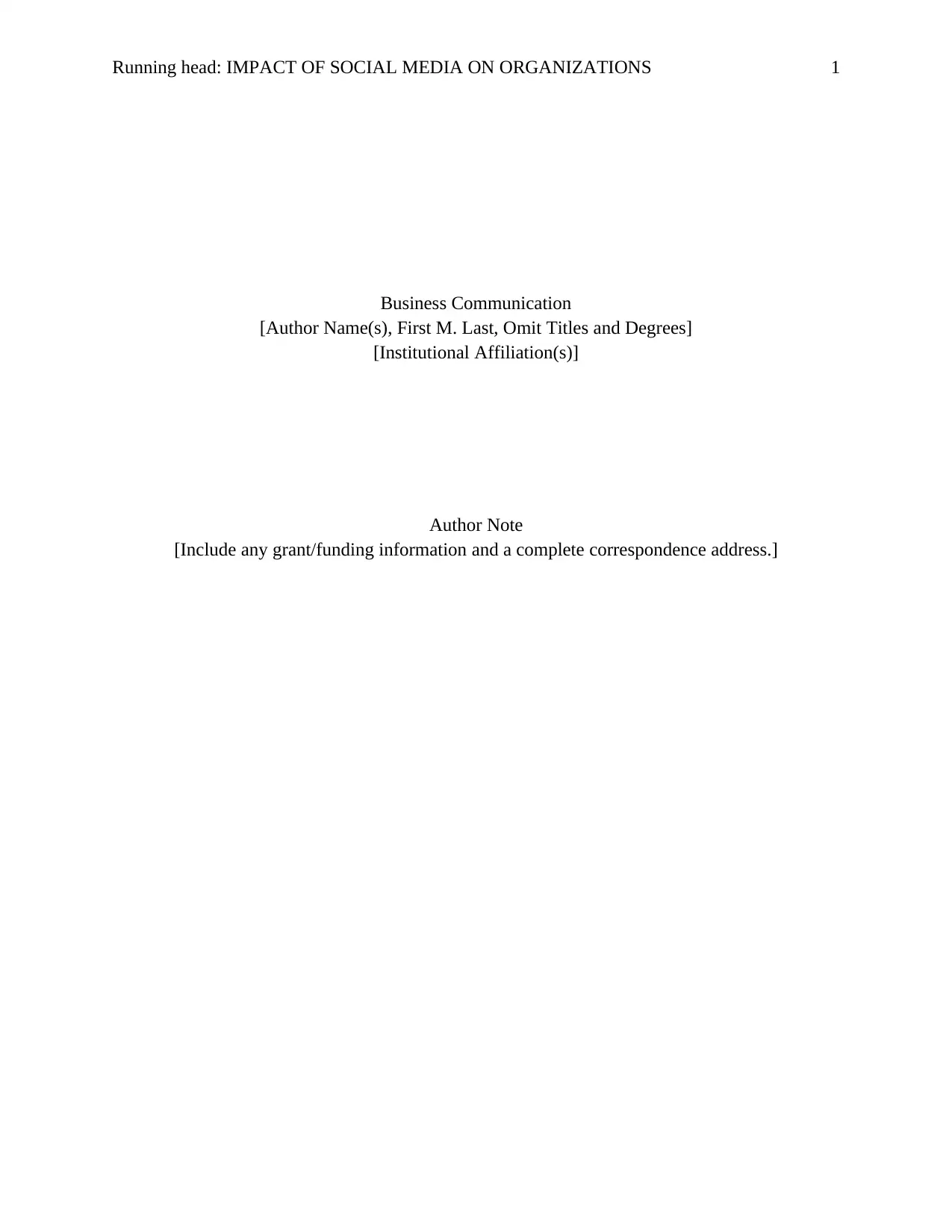
Running head: IMPACT OF SOCIAL MEDIA ON ORGANIZATIONS 1
Business Communication
[Author Name(s), First M. Last, Omit Titles and Degrees]
[Institutional Affiliation(s)]
Author Note
[Include any grant/funding information and a complete correspondence address.]
Business Communication
[Author Name(s), First M. Last, Omit Titles and Degrees]
[Institutional Affiliation(s)]
Author Note
[Include any grant/funding information and a complete correspondence address.]
Paraphrase This Document
Need a fresh take? Get an instant paraphrase of this document with our AI Paraphraser
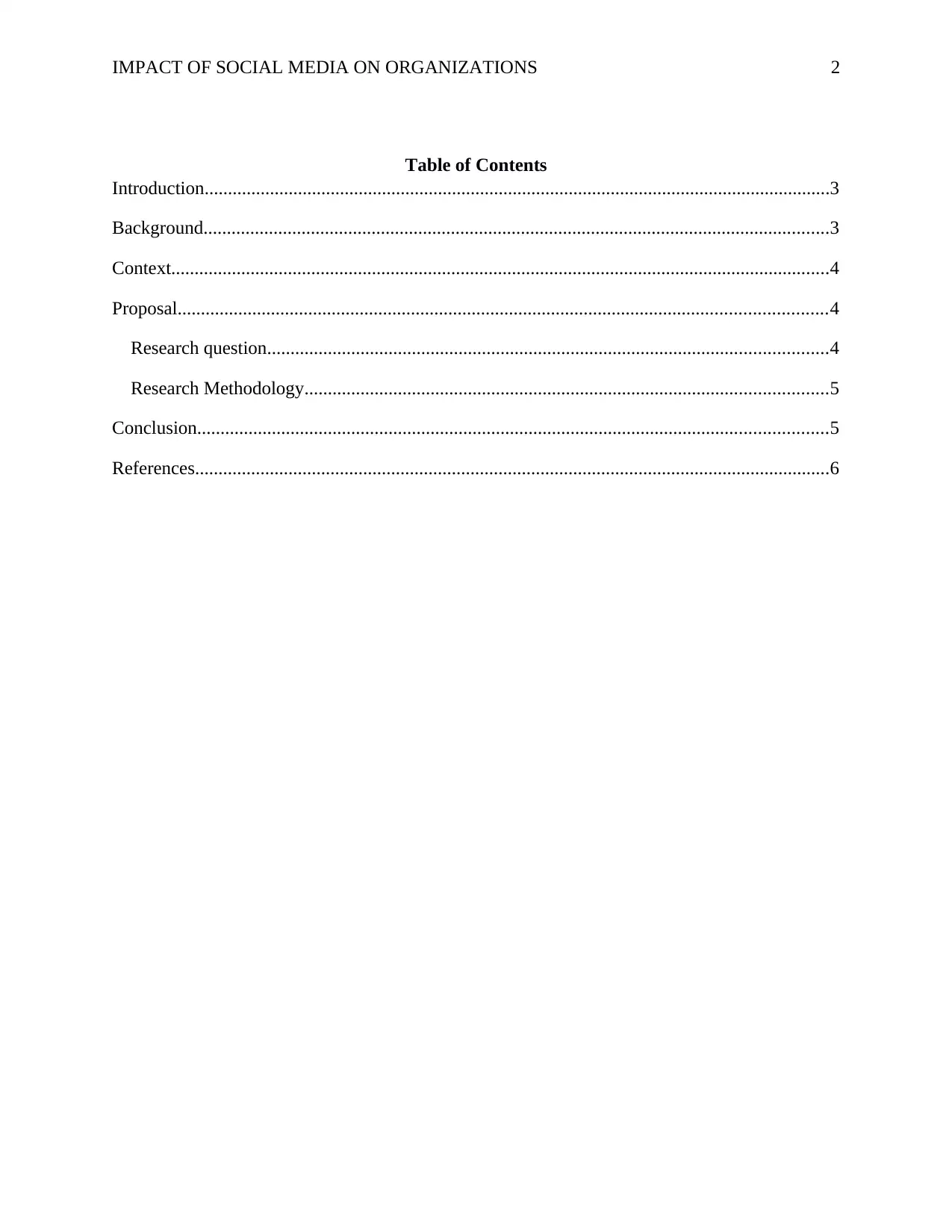
IMPACT OF SOCIAL MEDIA ON ORGANIZATIONS 2
Table of Contents
Introduction......................................................................................................................................3
Background......................................................................................................................................3
Context.............................................................................................................................................4
Proposal...........................................................................................................................................4
Research question........................................................................................................................4
Research Methodology................................................................................................................5
Conclusion.......................................................................................................................................5
References........................................................................................................................................6
Table of Contents
Introduction......................................................................................................................................3
Background......................................................................................................................................3
Context.............................................................................................................................................4
Proposal...........................................................................................................................................4
Research question........................................................................................................................4
Research Methodology................................................................................................................5
Conclusion.......................................................................................................................................5
References........................................................................................................................................6
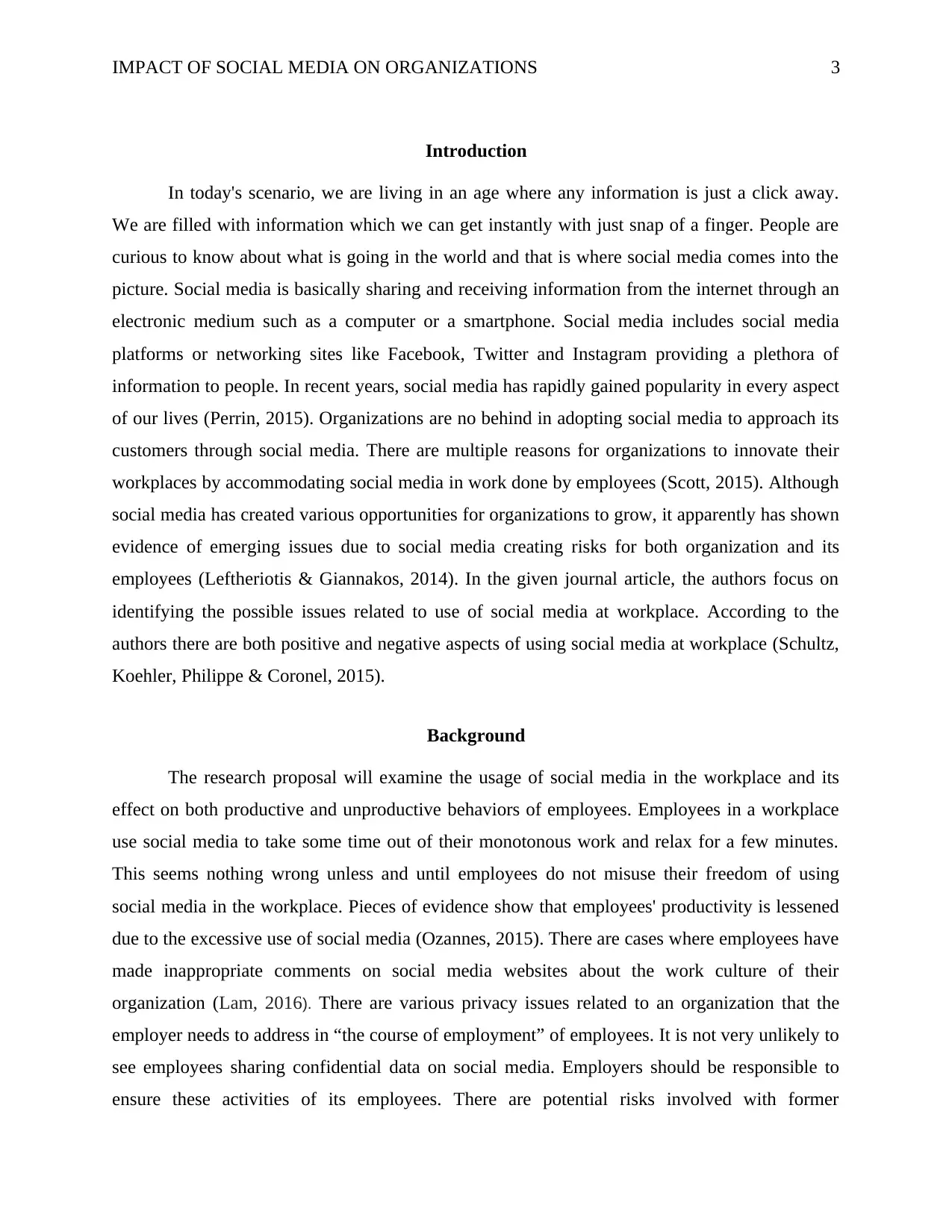
IMPACT OF SOCIAL MEDIA ON ORGANIZATIONS 3
Introduction
In today's scenario, we are living in an age where any information is just a click away.
We are filled with information which we can get instantly with just snap of a finger. People are
curious to know about what is going in the world and that is where social media comes into the
picture. Social media is basically sharing and receiving information from the internet through an
electronic medium such as a computer or a smartphone. Social media includes social media
platforms or networking sites like Facebook, Twitter and Instagram providing a plethora of
information to people. In recent years, social media has rapidly gained popularity in every aspect
of our lives (Perrin, 2015). Organizations are no behind in adopting social media to approach its
customers through social media. There are multiple reasons for organizations to innovate their
workplaces by accommodating social media in work done by employees (Scott, 2015). Although
social media has created various opportunities for organizations to grow, it apparently has shown
evidence of emerging issues due to social media creating risks for both organization and its
employees (Leftheriotis & Giannakos, 2014). In the given journal article, the authors focus on
identifying the possible issues related to use of social media at workplace. According to the
authors there are both positive and negative aspects of using social media at workplace (Schultz,
Koehler, Philippe & Coronel, 2015).
Background
The research proposal will examine the usage of social media in the workplace and its
effect on both productive and unproductive behaviors of employees. Employees in a workplace
use social media to take some time out of their monotonous work and relax for a few minutes.
This seems nothing wrong unless and until employees do not misuse their freedom of using
social media in the workplace. Pieces of evidence show that employees' productivity is lessened
due to the excessive use of social media (Ozannes, 2015). There are cases where employees have
made inappropriate comments on social media websites about the work culture of their
organization (Lam, 2016). There are various privacy issues related to an organization that the
employer needs to address in “the course of employment” of employees. It is not very unlikely to
see employees sharing confidential data on social media. Employers should be responsible to
ensure these activities of its employees. There are potential risks involved with former
Introduction
In today's scenario, we are living in an age where any information is just a click away.
We are filled with information which we can get instantly with just snap of a finger. People are
curious to know about what is going in the world and that is where social media comes into the
picture. Social media is basically sharing and receiving information from the internet through an
electronic medium such as a computer or a smartphone. Social media includes social media
platforms or networking sites like Facebook, Twitter and Instagram providing a plethora of
information to people. In recent years, social media has rapidly gained popularity in every aspect
of our lives (Perrin, 2015). Organizations are no behind in adopting social media to approach its
customers through social media. There are multiple reasons for organizations to innovate their
workplaces by accommodating social media in work done by employees (Scott, 2015). Although
social media has created various opportunities for organizations to grow, it apparently has shown
evidence of emerging issues due to social media creating risks for both organization and its
employees (Leftheriotis & Giannakos, 2014). In the given journal article, the authors focus on
identifying the possible issues related to use of social media at workplace. According to the
authors there are both positive and negative aspects of using social media at workplace (Schultz,
Koehler, Philippe & Coronel, 2015).
Background
The research proposal will examine the usage of social media in the workplace and its
effect on both productive and unproductive behaviors of employees. Employees in a workplace
use social media to take some time out of their monotonous work and relax for a few minutes.
This seems nothing wrong unless and until employees do not misuse their freedom of using
social media in the workplace. Pieces of evidence show that employees' productivity is lessened
due to the excessive use of social media (Ozannes, 2015). There are cases where employees have
made inappropriate comments on social media websites about the work culture of their
organization (Lam, 2016). There are various privacy issues related to an organization that the
employer needs to address in “the course of employment” of employees. It is not very unlikely to
see employees sharing confidential data on social media. Employers should be responsible to
ensure these activities of its employees. There are potential risks involved with former
⊘ This is a preview!⊘
Do you want full access?
Subscribe today to unlock all pages.

Trusted by 1+ million students worldwide
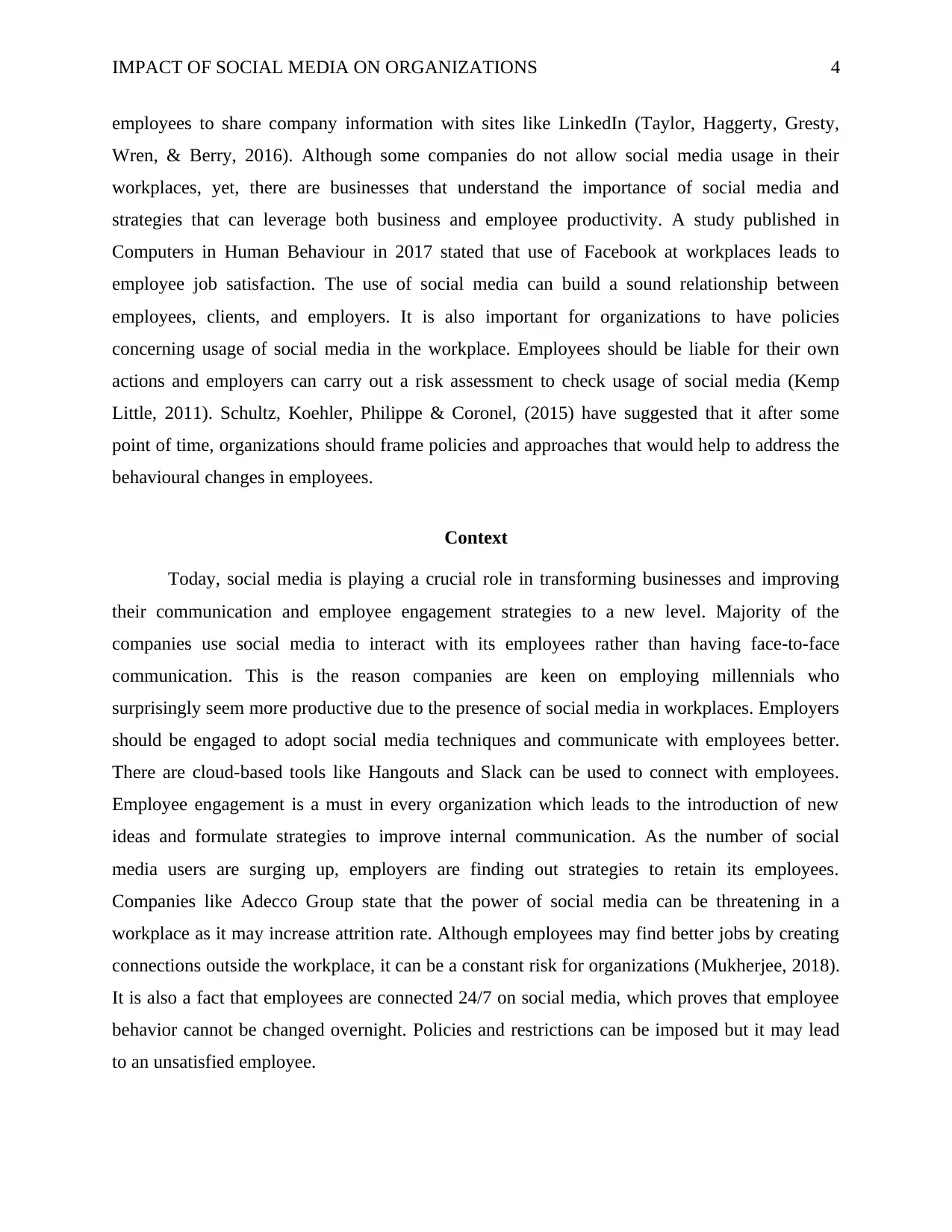
IMPACT OF SOCIAL MEDIA ON ORGANIZATIONS 4
employees to share company information with sites like LinkedIn (Taylor, Haggerty, Gresty,
Wren, & Berry, 2016). Although some companies do not allow social media usage in their
workplaces, yet, there are businesses that understand the importance of social media and
strategies that can leverage both business and employee productivity. A study published in
Computers in Human Behaviour in 2017 stated that use of Facebook at workplaces leads to
employee job satisfaction. The use of social media can build a sound relationship between
employees, clients, and employers. It is also important for organizations to have policies
concerning usage of social media in the workplace. Employees should be liable for their own
actions and employers can carry out a risk assessment to check usage of social media (Kemp
Little, 2011). Schultz, Koehler, Philippe & Coronel, (2015) have suggested that it after some
point of time, organizations should frame policies and approaches that would help to address the
behavioural changes in employees.
Context
Today, social media is playing a crucial role in transforming businesses and improving
their communication and employee engagement strategies to a new level. Majority of the
companies use social media to interact with its employees rather than having face-to-face
communication. This is the reason companies are keen on employing millennials who
surprisingly seem more productive due to the presence of social media in workplaces. Employers
should be engaged to adopt social media techniques and communicate with employees better.
There are cloud-based tools like Hangouts and Slack can be used to connect with employees.
Employee engagement is a must in every organization which leads to the introduction of new
ideas and formulate strategies to improve internal communication. As the number of social
media users are surging up, employers are finding out strategies to retain its employees.
Companies like Adecco Group state that the power of social media can be threatening in a
workplace as it may increase attrition rate. Although employees may find better jobs by creating
connections outside the workplace, it can be a constant risk for organizations (Mukherjee, 2018).
It is also a fact that employees are connected 24/7 on social media, which proves that employee
behavior cannot be changed overnight. Policies and restrictions can be imposed but it may lead
to an unsatisfied employee.
employees to share company information with sites like LinkedIn (Taylor, Haggerty, Gresty,
Wren, & Berry, 2016). Although some companies do not allow social media usage in their
workplaces, yet, there are businesses that understand the importance of social media and
strategies that can leverage both business and employee productivity. A study published in
Computers in Human Behaviour in 2017 stated that use of Facebook at workplaces leads to
employee job satisfaction. The use of social media can build a sound relationship between
employees, clients, and employers. It is also important for organizations to have policies
concerning usage of social media in the workplace. Employees should be liable for their own
actions and employers can carry out a risk assessment to check usage of social media (Kemp
Little, 2011). Schultz, Koehler, Philippe & Coronel, (2015) have suggested that it after some
point of time, organizations should frame policies and approaches that would help to address the
behavioural changes in employees.
Context
Today, social media is playing a crucial role in transforming businesses and improving
their communication and employee engagement strategies to a new level. Majority of the
companies use social media to interact with its employees rather than having face-to-face
communication. This is the reason companies are keen on employing millennials who
surprisingly seem more productive due to the presence of social media in workplaces. Employers
should be engaged to adopt social media techniques and communicate with employees better.
There are cloud-based tools like Hangouts and Slack can be used to connect with employees.
Employee engagement is a must in every organization which leads to the introduction of new
ideas and formulate strategies to improve internal communication. As the number of social
media users are surging up, employers are finding out strategies to retain its employees.
Companies like Adecco Group state that the power of social media can be threatening in a
workplace as it may increase attrition rate. Although employees may find better jobs by creating
connections outside the workplace, it can be a constant risk for organizations (Mukherjee, 2018).
It is also a fact that employees are connected 24/7 on social media, which proves that employee
behavior cannot be changed overnight. Policies and restrictions can be imposed but it may lead
to an unsatisfied employee.
Paraphrase This Document
Need a fresh take? Get an instant paraphrase of this document with our AI Paraphraser
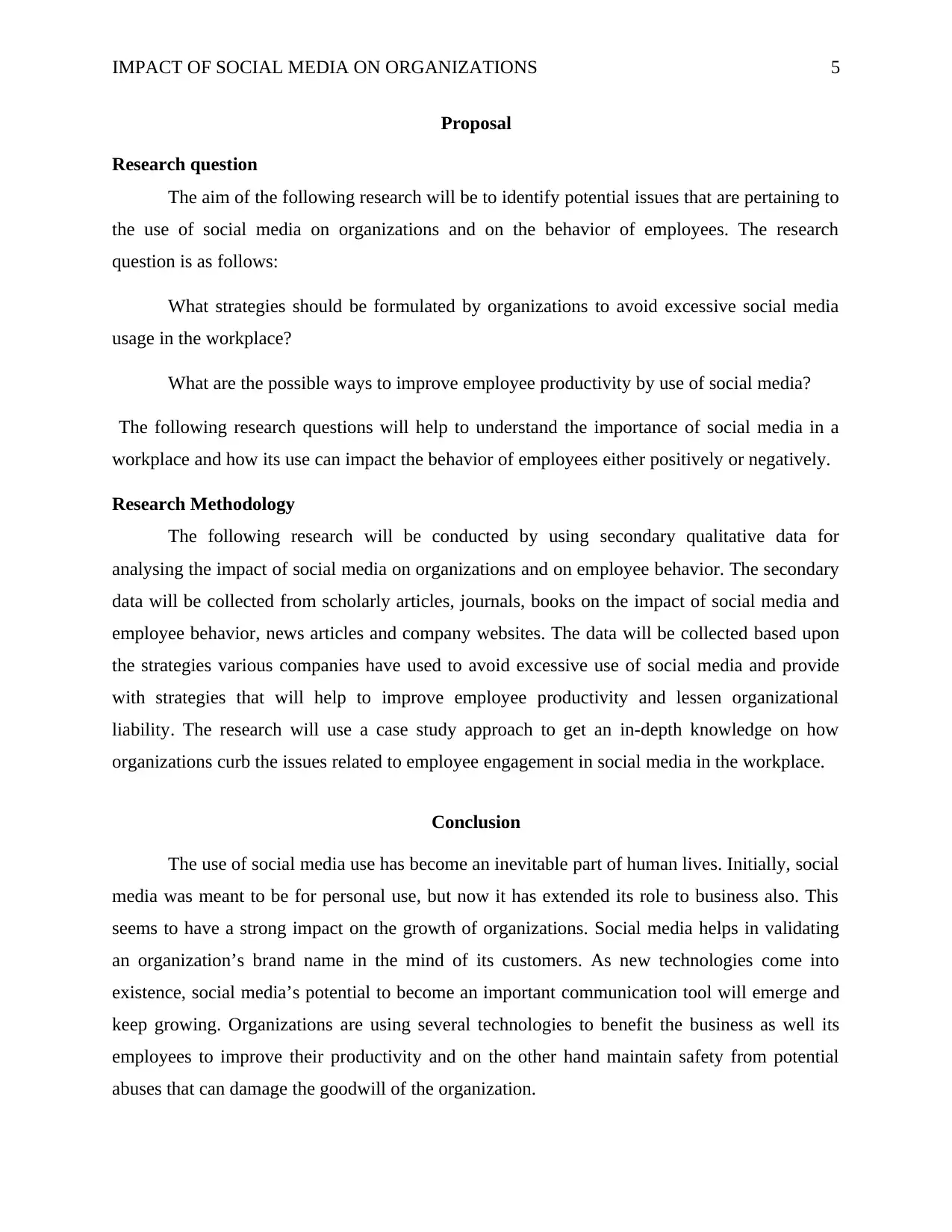
IMPACT OF SOCIAL MEDIA ON ORGANIZATIONS 5
Proposal
Research question
The aim of the following research will be to identify potential issues that are pertaining to
the use of social media on organizations and on the behavior of employees. The research
question is as follows:
What strategies should be formulated by organizations to avoid excessive social media
usage in the workplace?
What are the possible ways to improve employee productivity by use of social media?
The following research questions will help to understand the importance of social media in a
workplace and how its use can impact the behavior of employees either positively or negatively.
Research Methodology
The following research will be conducted by using secondary qualitative data for
analysing the impact of social media on organizations and on employee behavior. The secondary
data will be collected from scholarly articles, journals, books on the impact of social media and
employee behavior, news articles and company websites. The data will be collected based upon
the strategies various companies have used to avoid excessive use of social media and provide
with strategies that will help to improve employee productivity and lessen organizational
liability. The research will use a case study approach to get an in-depth knowledge on how
organizations curb the issues related to employee engagement in social media in the workplace.
Conclusion
The use of social media use has become an inevitable part of human lives. Initially, social
media was meant to be for personal use, but now it has extended its role to business also. This
seems to have a strong impact on the growth of organizations. Social media helps in validating
an organization’s brand name in the mind of its customers. As new technologies come into
existence, social media’s potential to become an important communication tool will emerge and
keep growing. Organizations are using several technologies to benefit the business as well its
employees to improve their productivity and on the other hand maintain safety from potential
abuses that can damage the goodwill of the organization.
Proposal
Research question
The aim of the following research will be to identify potential issues that are pertaining to
the use of social media on organizations and on the behavior of employees. The research
question is as follows:
What strategies should be formulated by organizations to avoid excessive social media
usage in the workplace?
What are the possible ways to improve employee productivity by use of social media?
The following research questions will help to understand the importance of social media in a
workplace and how its use can impact the behavior of employees either positively or negatively.
Research Methodology
The following research will be conducted by using secondary qualitative data for
analysing the impact of social media on organizations and on employee behavior. The secondary
data will be collected from scholarly articles, journals, books on the impact of social media and
employee behavior, news articles and company websites. The data will be collected based upon
the strategies various companies have used to avoid excessive use of social media and provide
with strategies that will help to improve employee productivity and lessen organizational
liability. The research will use a case study approach to get an in-depth knowledge on how
organizations curb the issues related to employee engagement in social media in the workplace.
Conclusion
The use of social media use has become an inevitable part of human lives. Initially, social
media was meant to be for personal use, but now it has extended its role to business also. This
seems to have a strong impact on the growth of organizations. Social media helps in validating
an organization’s brand name in the mind of its customers. As new technologies come into
existence, social media’s potential to become an important communication tool will emerge and
keep growing. Organizations are using several technologies to benefit the business as well its
employees to improve their productivity and on the other hand maintain safety from potential
abuses that can damage the goodwill of the organization.
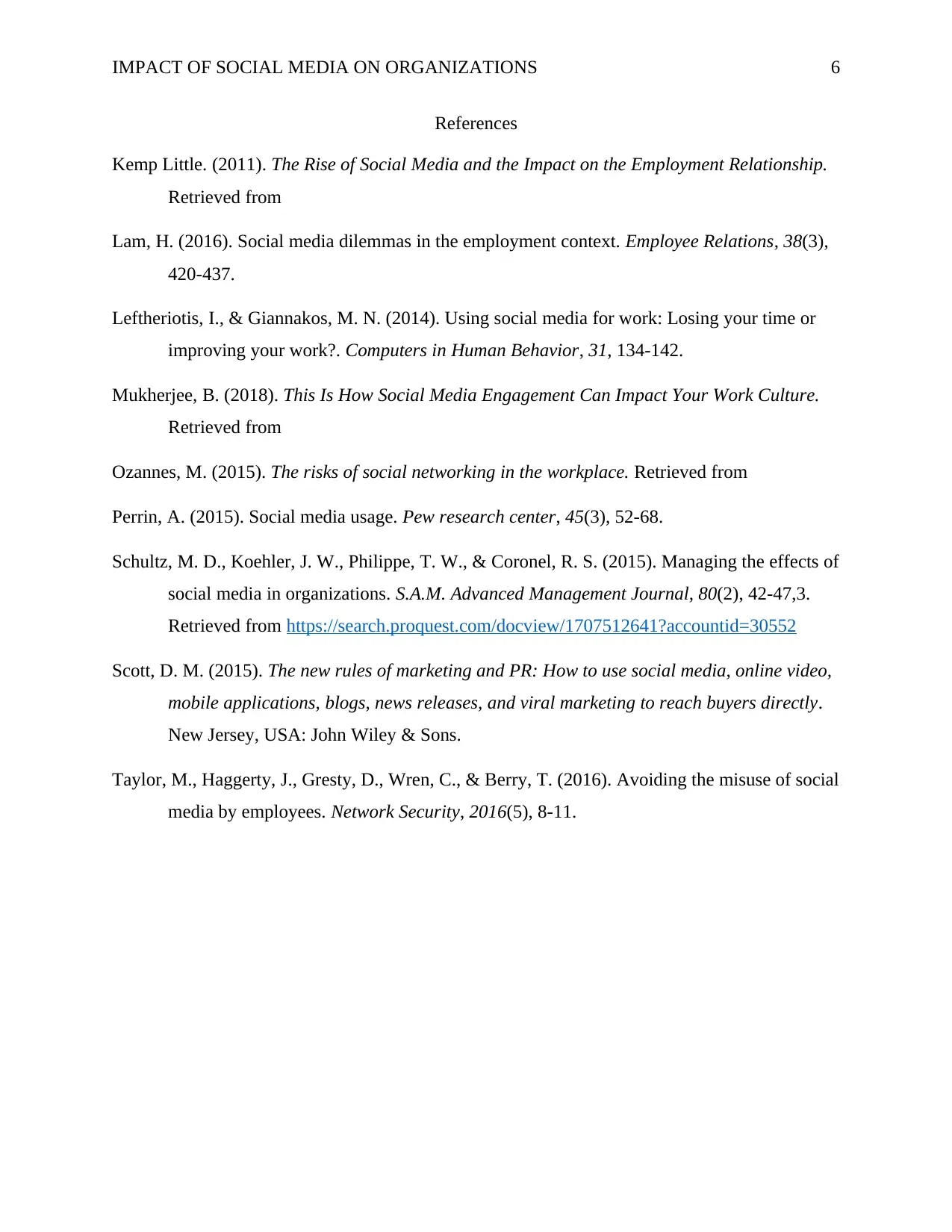
IMPACT OF SOCIAL MEDIA ON ORGANIZATIONS 6
References
Kemp Little. (2011). The Rise of Social Media and the Impact on the Employment Relationship.
Retrieved from
Lam, H. (2016). Social media dilemmas in the employment context. Employee Relations, 38(3),
420-437.
Leftheriotis, I., & Giannakos, M. N. (2014). Using social media for work: Losing your time or
improving your work?. Computers in Human Behavior, 31, 134-142.
Mukherjee, B. (2018). This Is How Social Media Engagement Can Impact Your Work Culture.
Retrieved from
Ozannes, M. (2015). The risks of social networking in the workplace. Retrieved from
Perrin, A. (2015). Social media usage. Pew research center, 45(3), 52-68.
Schultz, M. D., Koehler, J. W., Philippe, T. W., & Coronel, R. S. (2015). Managing the effects of
social media in organizations. S.A.M. Advanced Management Journal, 80(2), 42-47,3.
Retrieved from https://search.proquest.com/docview/1707512641?accountid=30552
Scott, D. M. (2015). The new rules of marketing and PR: How to use social media, online video,
mobile applications, blogs, news releases, and viral marketing to reach buyers directly.
New Jersey, USA: John Wiley & Sons.
Taylor, M., Haggerty, J., Gresty, D., Wren, C., & Berry, T. (2016). Avoiding the misuse of social
media by employees. Network Security, 2016(5), 8-11.
References
Kemp Little. (2011). The Rise of Social Media and the Impact on the Employment Relationship.
Retrieved from
Lam, H. (2016). Social media dilemmas in the employment context. Employee Relations, 38(3),
420-437.
Leftheriotis, I., & Giannakos, M. N. (2014). Using social media for work: Losing your time or
improving your work?. Computers in Human Behavior, 31, 134-142.
Mukherjee, B. (2018). This Is How Social Media Engagement Can Impact Your Work Culture.
Retrieved from
Ozannes, M. (2015). The risks of social networking in the workplace. Retrieved from
Perrin, A. (2015). Social media usage. Pew research center, 45(3), 52-68.
Schultz, M. D., Koehler, J. W., Philippe, T. W., & Coronel, R. S. (2015). Managing the effects of
social media in organizations. S.A.M. Advanced Management Journal, 80(2), 42-47,3.
Retrieved from https://search.proquest.com/docview/1707512641?accountid=30552
Scott, D. M. (2015). The new rules of marketing and PR: How to use social media, online video,
mobile applications, blogs, news releases, and viral marketing to reach buyers directly.
New Jersey, USA: John Wiley & Sons.
Taylor, M., Haggerty, J., Gresty, D., Wren, C., & Berry, T. (2016). Avoiding the misuse of social
media by employees. Network Security, 2016(5), 8-11.
⊘ This is a preview!⊘
Do you want full access?
Subscribe today to unlock all pages.

Trusted by 1+ million students worldwide
1 out of 6
Related Documents
Your All-in-One AI-Powered Toolkit for Academic Success.
+13062052269
info@desklib.com
Available 24*7 on WhatsApp / Email
![[object Object]](/_next/static/media/star-bottom.7253800d.svg)
Unlock your academic potential
Copyright © 2020–2025 A2Z Services. All Rights Reserved. Developed and managed by ZUCOL.





